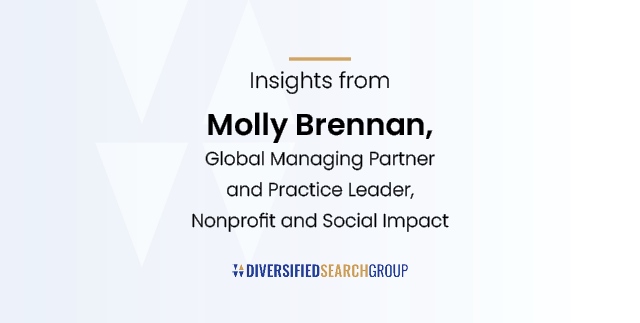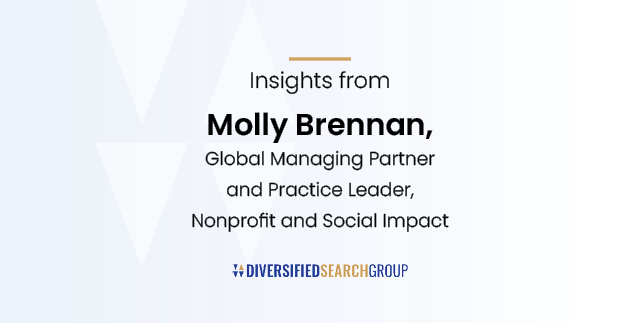Authenticity in Nonprofit Leadership

Merriam-Webster named authentic its 2023 word of the year. Forbes mentioned authenticity among the most important characteristics of nonprofit leaders.
What does this buzzword mean in practice, and how can you embrace and reflect authenticity at home and at work? We talked to Koya Partners | Diversified Search Group’s Senior Vice President, Inclusion and Equity, Maureen Alphonse-Charles, and Managing Directors Liz Lombard and Cassie Scarano to find out.
Developing your personal authenticity
Some of us may be intrinsically able to express our authenticity while others may need to develop that muscle. If you’re in the latter category, these tips may help.
- Self-reflection: It’s often easier said than done, but take time to reflect on what motivates and inspires you. It takes courage to be honest with yourself and to gaze unflinchingly at all the aspects of self; good, bad, and neutral, and to be at peace with them. Adopt a learning/ growth mindset- how can I continue to do better in the areas I am not as strong?
- Engagement with others and expanding your networks can expedite the development of one’s authenticity. Through these interactions you learn from others and further refine your own leadership skills. Mentors and sponsors are often huge assets towards building your confidence and finding your authentic voice.
- Seek out and spend time with those who lead with authenticity. Think about who in your personal and professional lives projects authenticity. How does it feel to be around them? What do they say and do that is true and authentic? Can you adopt any of those practices or approaches?
Leading with authenticity
Authentic nonprofit leaders make their voices heard and make decisions in ways that are aligned with their core beliefs. They lead with transparency and truth, and they know when they need to bring in expertise and skills they do not have themselves. Here are some tips for being a more authentic leader:
- Create and extend a safe environment: Psychological safety, or the feeling that it’s OK to make mistakes, be honest, and bring your authentic self to work, is critical for creating genuine connections and ensuring that professionals of color and other underrepresented groups don’t spend too much energy masking parts of themselves.
- Lead with a low ego: Be honest about what you know and do not know and lead with transparency. Staff members appreciate that vulnerability and it can be an opportunity to bring people with other strengths into the decision making process.
- Be adaptable. Authentic leadership is dynamic. It responds to nuances. It takes additional facts into account. It never rests on its laurels or assumes that it has all issues analyzed and covered. It should take instruction, learn new ways of thinking and apply that recently acquired knowledge to the issues of the day. Exercise the right to change your mind.
By embracing transparent communication, fostering genuine collaboration, staying flexible, and embodying these authentic leadership principles, you can establish a positive and authentic nonprofit working environment.
By Allison Dunne, Vice President, Business Development
Koya Partners | Diversified Search Group
Related articles
-
?>
-

Education, For Job Seekers, Insights, Thought Leadership
So You Want to Be a Head of School: Guidelines and Guardrails for Independent School Aspiring Heads
You understand the assignment, as today’s kids say. You know the Head’s role well, perhaps...
?>
-

For Job Seekers
Authenticity in Nonprofit Leadership
Merriam-Webster named authentic its 2023 word of the year. Forbes mentioned authenticity among the most...
?>
-

For Job Seekers
Authenticity in Nonprofit Leadership
Title: Authenticity in Nonprofit Leadership Merriam-Webster named authentic its 2023 word of the year. Forbes...
?>
-

For Boards, Search Committees and Hiring Managers, For Job Seekers
PND: Five Skills Every Nonprofit Leader Needs
Molly Brennan, Global Managing Partner and Practice Leader, Nonprofit and Social Impact, offers thoughts on...
?>
-

For Job Seekers
Best Practices for Presenting Yourself and Networking
Networking is a critical for any professional. Whether you are looking for a new role...
?>
-

For Boards, Search Committees and Hiring Managers, For Job Seekers
9 Ways to Make Virtual Meetings More Inclusive
In addition to disruptions to most other areas of our lives, many of us have...
?>
-
For Job Seekers
How to Ask for an Informational Interview
Asking someone for an informational interview is an opportunity to build a reciprocal relationship...
?>
-

For Job Seekers
8 Easy Networking Tips for Busy People
We all know that networking is a key building block for professional advancement. But with...
?>
-

For Job Seekers
PND: How to make your case for a raise
Molly Brennan, Global Managing Partner and Practice Leader, Nonprofit and Social Impact, offers her recommendations...
?>
-

For Boards, Search Committees and Hiring Managers, For Job Seekers, Insights, Nonprofit, Recruiting & Hiring, Thought Leadership
Four things hiring managers and candidates should know before interviewing
Interviewing is an integral part of the hiring process — one that rarely goes as...
?>
-

For Job Seekers, Insights
11 Insightful Questions to Ask a Recruiter
Rather than ignoring the next email or call you get from a recruiter, think of it as a learning opportunity — even if you aren’t seriously considering leaving your current position.